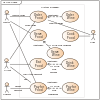Profile diagram
Appearance

| UML diagram types |
|---|
| Structural UML diagrams |
| Behavioral UML diagrams |
This article provides insufficient context for those unfamiliar with the subject. (February 2012) |
A profile diagram operates at the metamodel level to show stereotypes as classes with the «stereotype» stereotype, and profiles as packages with the «profile» stereotype.[1] The extension relation (solid line with closed, filled arrowhead) indicates what metamodel element a given stereotype is extending.
History
The profile diagram didn't exist in UML 1. It was introduced with UML 2 to display the usage of profiles. Before its introduction, other diagrams had been used to display this issue.[1]
See also
References
- ^ a b Bernd Österreich (2009). Analyse und Design mit UML 2.3 - Objektorientierte Softwareentwicklung (in German) (9 ed.). Munich: Oldenburg. p. 334. ISBN 978-3-486-58855-2.
- Christoph Kecher: "UML 2.0 - Das umfassende Handbuch" Galileo Computing, 2006, ISBN 3-89842-738-2

